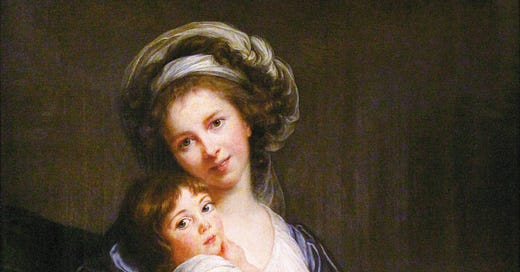The self portraits of Élisabeth Vigée le Brun
How they tell the story of one of the great portraitists in history
While I was painting my last family portrait recently, I was looking into how other artists have depicted themselves with their families. Some are quite official looking, like the impressive self-portrait of the artist with his wife Suzanne and children by Cornelis de Vos. Others hint at the domestic inner life of the family such as Sofonisba Anguissola’s portrait of herself and her sisters playing chess.
There is the Jacob Jordaens family portrait, a remarkable, crowded (he was the eldest of eleven children) and somewhat melancholic painting where we see the artist seated to the left, playing the lute. His father sits beside him and his mother across the table looking down, towards her other children, her youngest on her knee. Flying above them as cherubs are the souls of other children since passed.
Upon seeing more and more portraits, I rediscovered the first of two self-portraits of Élisabeth Vigée Le Brun (1755 – 1842) with her daughter Julie, titled Madame Vigée le Brun and her daughter, painted in 1786.
The painting took my breath away.
Why?
I’m not sure exactly. Maybe it’s the expressions on their faces, so bright and filled with warmth. Or it could be the way they are embracing, their heads tilted towards each other. Perhaps its the way in which it is painted, where the glow of their skin and dress converge in a triangular composition leading our eyes directly towards their own where we hold each others’ gaze.
Simply put, it is portrait of the artist as an adoring parent together with her child. Save for a plethora of Madonna and Child paintings, we rarely see such genuine depictions of parental love, especially where the artist herself and her child are the subjects.
Vigée le Brun is able to convey that powerful feeling of affection and pride she feels for her beloved daughter, whom she called “Brunette.” She looks back at us, with her eyes open, smiling—actually revealing her teeth! It’s an expression that is quite rare in portraiture save for in Holland with artists such as Frans Hals and Judith Leyster but often looked down upon in French painting of the day. One critic even went so far as to say that Vigée le Brun’s display of teeth was “an affectation which artists, connoisseurs, and people of good taste are unanimous in condemning.”
Keep reading with a 7-day free trial
Subscribe to Jun-Pierre Art Notes to keep reading this post and get 7 days of free access to the full post archives.




